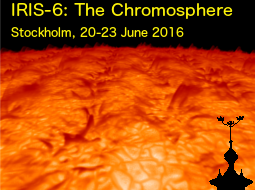Speaker
V. Hansteen
Description
We study the ascent of granular-sized magnetic bubbles from the solar photosphere
through the chromosphere into the transition region and above, for the first time.
Such events occurred in a flux emerging region in NOAA 11850 on September 25, 2013.
During that time, the first co-observing campaign between the Swedish 1-m Solar
Telescope and the IRIS spacecraft was carried out. Simultaneous observations of the
chromospheric H$\alpha$ 656.28 nm and \ion{Ca}{2} 854.2 nm lines, plus the
photospheric \ion{Fe}{1} 630.25 nm line, were made with the CRISP spectropolarimeter
at the SST reaching a spatial resolution of 0.14. At the same time, IRIS was
performing a four-step dense raster of the said emerging flux region, taking slit-jaw
images at 133 (C~{\sc ii}, transition region), 140 (\ion{Si}{4}, transition region),
279.6 (\ion{Mg}{2} k, core, upper chromosphere), and 283.2 nm (\ion{Mg}{2} k, wing,
photosphere). Spectroscopy of several lines was performed by the IRIS spectrograph in
the far and near ultraviolet, of which we have used the \ion{Si}{4} 140.3 and the
\ion{Mg}{2} k 279.6 nm lines. Coronal images from the Atmospheric Imaging Assembly of
the Solar Dynamics Observatory were used to investigate the possible coronal
signatures of the flux emergence events. The photospheric and chromospheric
properties of small-scale emerging magnetic bubbles have been described in detail in
Ortiz et al. (2014). Here we are able to follow such structures up to the transition
region. We describe the properties, including temporal delays, of the observed flux
emergence in all layers. We believe this may be an important mechanism of
transporting energy and magnetic flux from subsurface layers to the transition region
and corona. "
Primary author
Ada Ortiz Carbonell
(Instituto de Astrofisica de Andalucia-CSIC)

